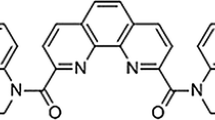Abstract
The extraction behavior of Am(IV–VI) from high pH solutions in the presence of carbonates, pyrophosphates or polyphosphates of alkali metals and of Np(VI–VII) from alkaline solutions with acylpyrazolones (1-phenyl-3-methyl-4-benzoylpyrazolone-5, PMBP) and extractants of the phenol type [bis(2-oxy-4-alkyl-benzoil)amin, CAAF] has been studied. The extraction ability of phenolic extractants with respects to Np(VII) is determined generally by its state in the alkaline solution. Maximum extraction is observed when Np(VII) is present as hydroxo complex and minimum extraction, when the solution contains oxo-ions. During the extraction the reduction of Np(VII) to Np(VI) is possible. Hexavalent neptunium can be extracted by phenol extractants too, but more slowly and with smaller distribution coefficients in comparison with Np(VII). The stabilization of transplutonium elements (TPE) in the highest oxidation states in alkaline solutions contaning carbonate and pyrophosphate ions, in combination with extraction by PMBP and CAAF, allows to realize the separation of transplutonium elements which are very similar in their properties. Methods of separation for americium and curium have been developed. They are based on the ability of trivalent curium to be extracted quantitatively from 0.1M sodium pyrophosphate solution (pH 10) and 1.0M potassium carbonate solution (ph 13.4) by PMBP in chloroform and by CAAF in carbon tetrachloride, respectively, with high distribution coefficients, whereas americium which is electrochemically oxidized to Am(VI) in these media, remains in the aqueous phase, since it reduces only to Am(V) when contacting the extractant. The separation factor of the couple Cm(III) Am(VI) is about 103.
Similar content being viewed by others
References
Z. K. KARALOVA, B. F. MYASOEDOV, T. I. BUKHINA, E. A. LAVRINOVICH, Solvent Extr. Ion Exch., 6 (1988) 1109.
Z. K. KARALOVA, T. I. BUKHINA, E. A. LAVRINOVICH, T. I. TROFIMOV, Yu. M. KULYAKO, B. F. MYASOEDOV, Radiochemistry, 30 (1988) 203.
Z. K. KARALOVA, E. A. LAVRINOVICH, T. I. TROFIMOV, Yu. M. KULYAKO, B. F. MYASOEDOV, Radiochemistry, 31 (1989) 76.
Z. K. KARALOVA, E. A. LAVRINOVICH, S. A. IVANOVA, B. F. MYASOEDOV, Radiochemistry, 32 (1990) 81.
Author information
Authors and Affiliations
Rights and permissions
About this article
Cite this article
Karalova, Z.I., Lavrinovich, E.A. & Myasoedov, B.F. Use of actinides in uncommon oxidation states for their extraction and separation from alkaline solutions. Journal of Radioanalytical and Nuclear Chemistry, Articles 159, 259–266 (1992). https://doi.org/10.1007/BF02040719
Received:
Issue Date:
DOI: https://doi.org/10.1007/BF02040719




